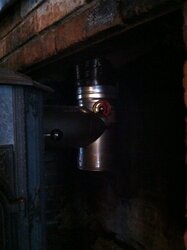My stovetop therm usually reads 400 - 650 or so when the stove is lit and cat engaged. I have the therm placed above the cat, which is in a cast iron hood that probably gives a good bit of heat in and of itself.
On the flue pipe, I have a short tee, non-magnetic, so DH and I attached a therm with thin wire. That therm never gets above 200, even with the stovetop at 600+ 12 inches away.
What am I doing wrong?
Thanks!
Mary
On the flue pipe, I have a short tee, non-magnetic, so DH and I attached a therm with thin wire. That therm never gets above 200, even with the stovetop at 600+ 12 inches away.
What am I doing wrong?
Thanks!
Mary





